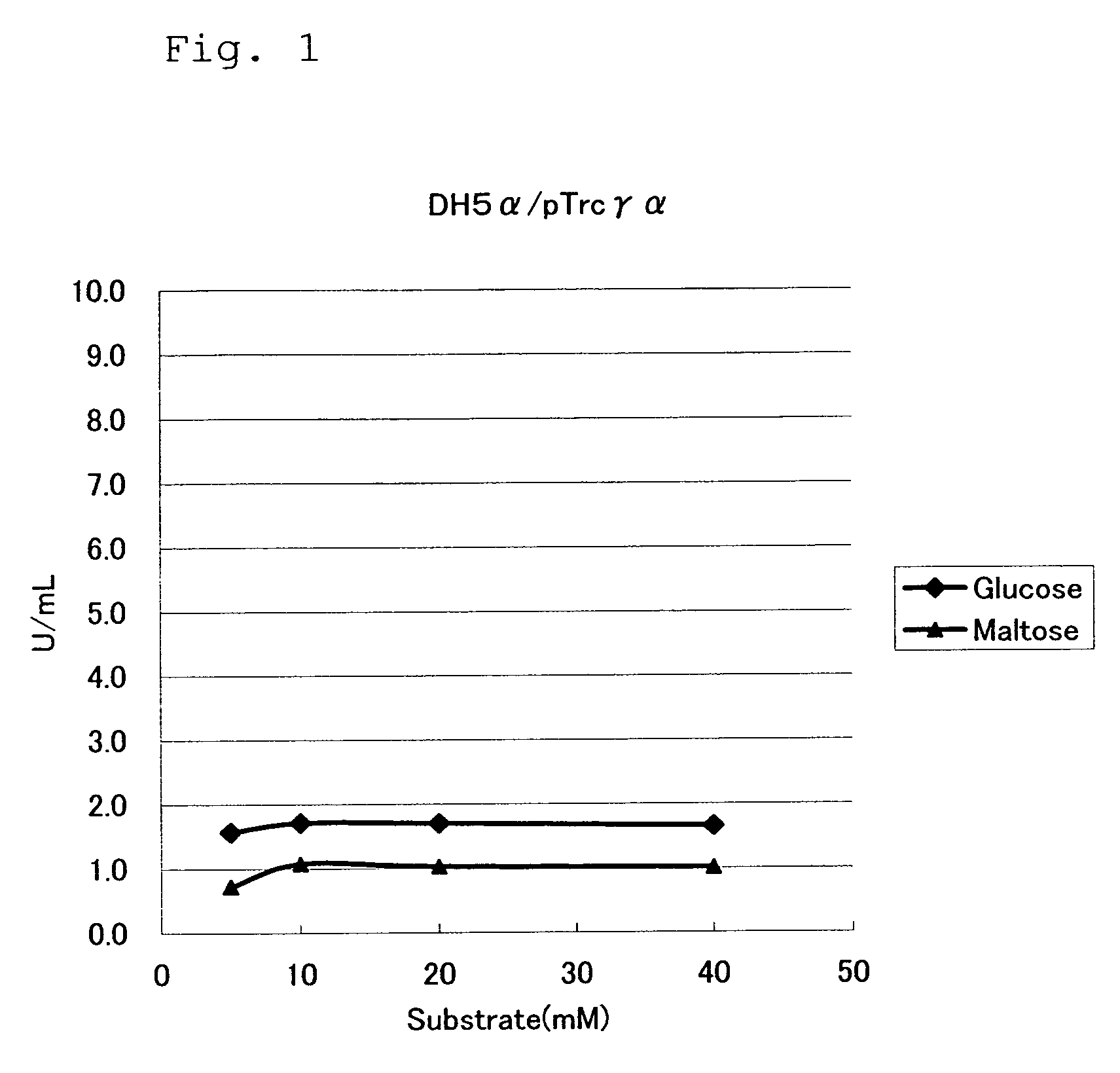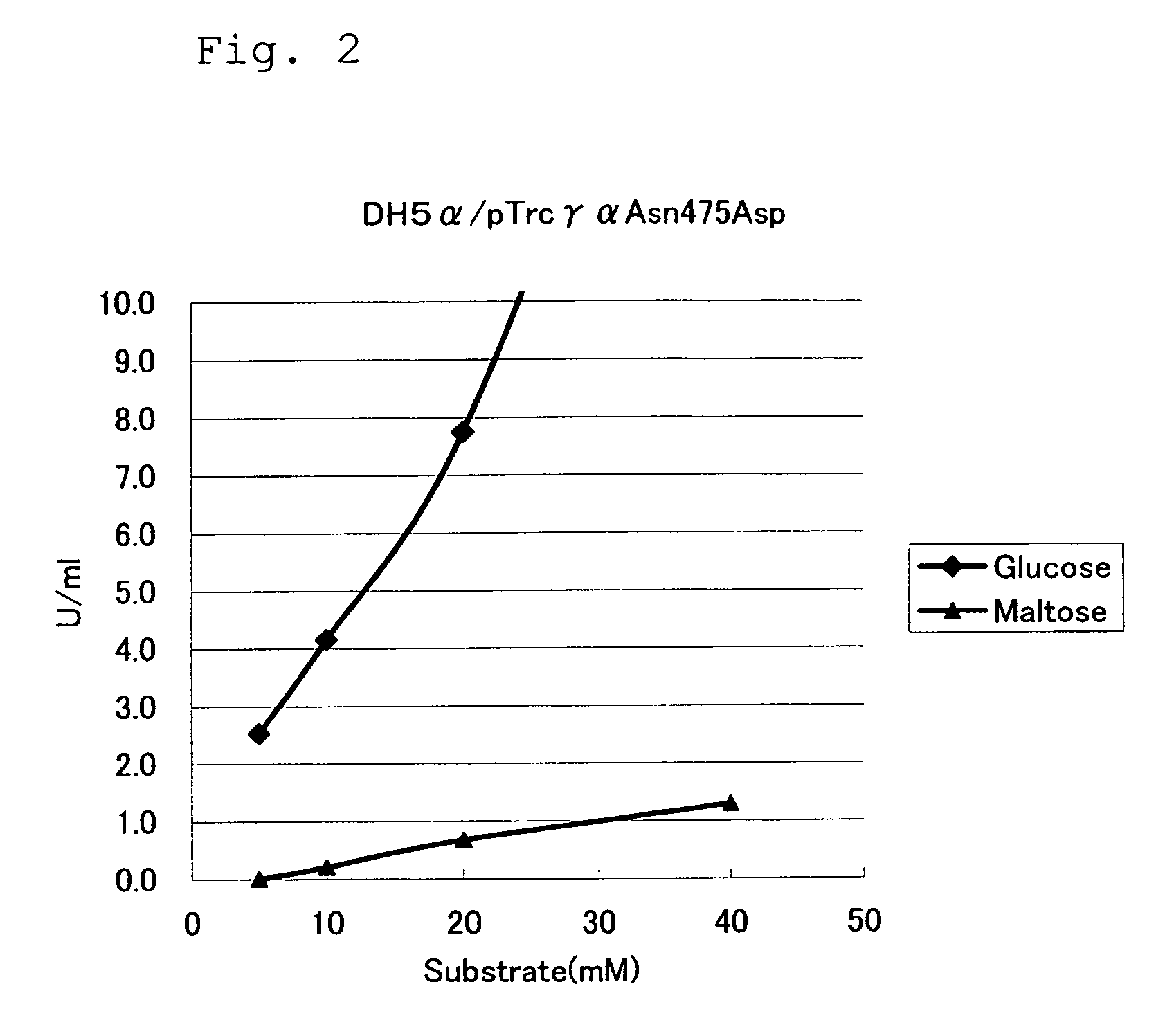Mutant Glucose Dehydrogenase
a glucose dehydrogenase and glucose technology, applied in the field of mutation glucose dehydrogenase, can solve the problems of affecting the dissolved oxygen, the risk of obtaining values higher than the true blood sugar level, etc., and achieve the effect of improving the specificity of the substrate to glucos
- Summary
- Abstract
- Description
- Claims
- Application Information
AI Technical Summary
Benefits of technology
Problems solved by technology
Method used
Image
Examples
example 1
Plasmids expressing GDH of Burkhorderia cepacia
[0058]As plasmids expressing GDH of Burkhorderia cepacia, a plasmid expressing the GDH α-subunit and γ-subunit and a plasmid expressing the α-subunit, β-subunit and γ-subunit were prepared.
Plasmid Expressing GDH α-Subunit and γ-Subunit
[0059]As a plasmid expressing the α-subunit and γ-subunit, plasmid pTrc99A / γ+α described in WO02 / 036779 was used. This plasmid is a plasmid obtained by inserting a DNA fragment sequentially containing the GDH γ-subunit structural gene and the α-subunit structural gene isolated from chromosomal DNA of the Burkhorderia cepacia KS1 strain (FERM BP-7306) into the vector pTrc99A (Pharmacia) at the NcoI / HindIII site as a cloning site thereof. The GDHγα gene in this plasmid is regulated by the trc promoter. pTrc99A / γ+α has an ampicillin resistance gene.
Plasmid Expressing GDH α-Subunit, β-Subunit and γ-Subunit
[0060]A plasmid expressing the GDH α-subunit, β-subunit and γ-subunit was prepared as follows.
(1) Prepara...
example 2
Introduction of Mutation into GDH α-Subunit Gene
[0064]By using a commercially available site-directed mutatgenesis kit (QuikChangeII Site-Directed Mutagenesis Kit, Stratagene), the codon of aspartic acid (GAT) or glutamic acid (GAA) was substituted for the codon of the 475th asparagine (AAT) in the GDH α-subunit gene contained in the plasmids pTrc99A / γ+α and pTrc99Aγαβ described in Example 1. As primers, the following oligonucleotides were used. Hereinafter, substitution of an aspartic acid residue for the 475th asparagine residue is referred to as “Asn475Asp”, and substitution of a glutamic acid residue for the 475th asparagine residue is referred to as “Asn475Glu”.
Primers for Asn475Asp substitution[Forward primer](SEQ ID NO: 7)5′-CGCGCCGAACGATCACATCACGGGC-3′[Reverse primer](SEQ ID NO: 8)5′-GCCCGTGATGTGATCGTTCGGCGCG-3′Primers for Asn475Glu substitution[Forward primer](SEQ ID NO: 9)5′-GAATTCGCGCCGAACGAACACATCAGGGGCTCG-3′[Reverse primer](SEQ ID NO: 10)5′-CGAGCCCGTGATGTGTTCGTTCGGCGCGA...
example 3
Analysis of Substrate Specificity of Mutant GDHs
[0068]Mutant GDHs were produced by using the mutant GDH expressing plasmids obtained in Example 2, and substrate specificities thereof were examined.
(1) Culture
[0069]The Escherichia coli DH5a strain introduced with pTrcγαAsn475Glu and pTrcγαβAsn475Glu were each cultured overnight at 37° C. in 2 ml of the LB medium (containing 50 μg / ml of ampicillin and 30 μg / ml of kanamycin) in an L-shaped tube with shaking. These culture broths were inoculated in 150 ml of the LB medium (containing 50 μg / ml of ampicillin and 30 μg / ml of kanamycin) contained in a 500-ml Sakaguchi flask, and the cells were cultured at 37° C. with shaking. After 3 hours from the start of culture, isopropyl-β-D-thiogalactopyranoside (IPTG) was added at a final concentration of 0.1 mM, and the cells were further cultured for 2 hours.
(2) Preparation of Enzyme Samples
[0070]The cells were collected from each culture broth obtained as described above, washed, then suspended in...
PUM
| Property | Measurement | Unit |
|---|---|---|
| Fraction | aaaaa | aaaaa |
| Volume | aaaaa | aaaaa |
| Volume | aaaaa | aaaaa |
Abstract
Description
Claims
Application Information
 Login to View More
Login to View More - R&D
- Intellectual Property
- Life Sciences
- Materials
- Tech Scout
- Unparalleled Data Quality
- Higher Quality Content
- 60% Fewer Hallucinations
Browse by: Latest US Patents, China's latest patents, Technical Efficacy Thesaurus, Application Domain, Technology Topic, Popular Technical Reports.
© 2025 PatSnap. All rights reserved.Legal|Privacy policy|Modern Slavery Act Transparency Statement|Sitemap|About US| Contact US: help@patsnap.com



